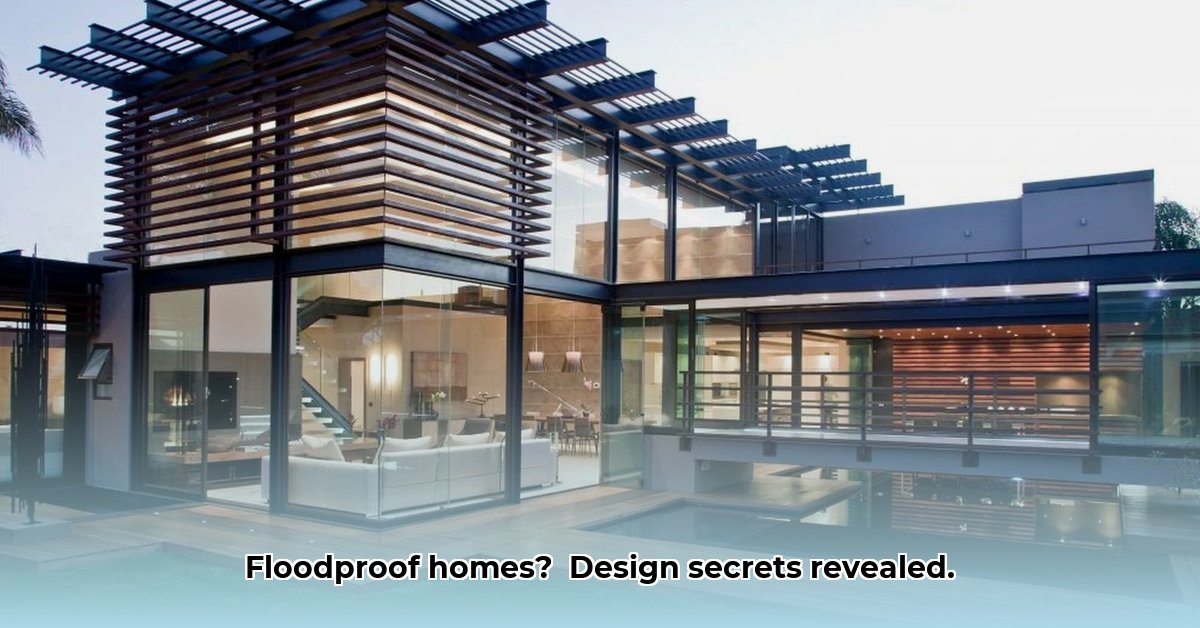Floods are becoming increasingly frequent and intense, making it essential to construct homes that can withstand these natural disasters. This comprehensive guide offers essential information for homeowners, architects, and community planners to build flood-resistant homes. We’ll delve into understanding flood risks, selecting appropriate building methods, exploring innovative materials and technologies, and examining real-world examples of successful flood-proof homes, providing a roadmap for creating safer and more resilient living spaces. For modern architectural inspiration, check out these flat roof designs.
Understanding Flood Risks and Mitigation Techniques
Building a flood-proof house starts with understanding the specific flood threats in your area and choosing the right mitigation techniques. Different flood types, like riverine, coastal, and flash floods, pose unique challenges and require tailored strategies.
Assessing Flood Threats: Tailoring Strategies to Your Location
Different types of flood events mean the mitigation techniques also vary. Riverine floods involve a slow, steady rise of water, while coastal floods can be sudden and powerful, often accompanied by storm surges. Flash floods, on the other hand, are rapid and destructive, often leaving little time for preparation. Understanding these differences is crucial for selecting appropriate flood-proofing measures.
The first step is to determine your property’s Base Flood Elevation (BFE) and Design Flood Elevation (DFE). These measurements indicate the likely height of floodwaters during a major event and the elevation you should design for, providing a benchmark for designing flood-resistant structures. This information is typically available from local government planning departments or FEMA (Federal Emergency Management Agency) flood maps. Knowing your BFE and DFE helps guide your design choices and prevents the construction of homes on vulnerable ground. For instance, you can use the estimated flood height to determine how high to elevate the foundation. In New York City, for example, the DFE must be at least two feet above the BFE.
Dry vs. Wet Flood-Proofing: Choosing the Right Approach
There are two primary methods for protecting a home from floodwaters: dry and wet flood-proofing.
Dry flood-proofing aims to create an impenetrable barrier, completely sealing the house to prevent water from entering. Techniques include waterproof coatings, reinforced walls, and special seals for doors and windows.
Wet flood-proofing, on the other hand, allows water to enter specific areas, like basements or garages, but designs these areas to withstand flooding and minimize damage. This involves using water-resistant materials and elevating essential utilities.
The optimal approach depends heavily on budget, location, and risk tolerance. Consulting with an experienced architect proves invaluable in determining the most suitable strategy for your unique circumstances, balancing cost-effectiveness with the desired level of protection.
Elevated Foundations: A Key Structural Element
Elevating your house above the projected flood level represents one of the most effective strategies for flood protection. This involves constructing the house on stilts or an elevated foundation, keeping the main living spaces dry even if the surrounding area floods. This also allows floodwaters to pass underneath the building, reducing hydrostatic pressure on the structure.
Selecting the right foundation material is crucial. Concrete offers exceptional durability and water resistance but may be more expensive. Steel provides strength at a relatively lighter weight but requires protective coatings to prevent corrosion. Pressure-treated lumber represents a more budget-friendly option, requiring careful treatment to prevent rot and pest infestation. Homes can be elevated on columns made of masonry, concrete, steel, or wood.
Regardless of the material chosen, watertight seals around doors, windows, and utility penetrations are essential to prevent water intrusion. These seals act as a last line of defense, ensuring the effectiveness of the elevated foundation.
Innovative Technologies in Modern Flood-Proof House Design: Embracing the Future
Flood-resistant design continues to evolve. Some of the technologies include buoyant foundations, smart materials, prefabricated modular homes.
- Buoyant Foundations: These foundations allow a house to float during a flood, minimizing damage and offering a potential solution for areas prone to extreme flooding. Ongoing research aims to improve the design and durability of these systems. Examples include using recycled plastic barrels for buoyancy.
- Smart Materials: These materials react to moisture, automatically sealing themselves to prevent water damage.
- Prefabricated Modular Homes: Building houses off-site in sections can reduce construction time, improve quality control, and facilitate easier relocation or repair after a flood.
Step-by-Step Guide: Building a Flood-Resilient Home
Constructing a flood-resistant home involves several steps, demanding careful planning and execution.
Step 1: Assess Your Flood Risk. Determine your BFE and DFE and understand the types of flooding likely to affect your property. Consult FEMA flood maps and local government resources.
Step 2: Choose Your Design Approach. Decide between dry or wet flood-proofing, which will influence subsequent decisions.
Step 3: Select Appropriate Materials. Consider the pros and cons of concrete, steel, and treated lumber.
Step 4: Engage a Qualified Professional. An experienced architect and engineer can provide the expertise needed for success.
Step 5: Obtain Necessary Permits. Comply with all local building codes and regulations to ensure structural integrity and safety.
Step 6: Build and Inspect. Pay meticulous attention to detail during construction, with regular inspections to ensure quality and compliance.
Material Selection: Weighing the Options
Choosing the right materials for flood-resistant construction involves considering the advantages and disadvantages of each.
| Material | Pros | Cons |
|---|---|---|
| Concrete | Durable, water-resistant, fire-resistant | High cost, potential cracking |
| Steel | Strong, lightweight, non-combustible | Susceptible to corrosion, more complex detailing required than wood frame |
| Treated Lumber | Cost-effective, aesthetically versatile, readily available | Requires treatment to prevent rot and pests, flammable |
Case Studies: Learning from Real-World Examples
Examining successful projects worldwide provides valuable insights into the effectiveness of modern flood-proof house design. These examples demonstrate how innovative techniques can create beautiful, functional, and resilient homes, securing your family and investment for the future. Examples would include the Float House in New Orleans, and amphibious homes in the Netherlands.
Collaboration: A Community-Wide Approach
Building flood-resistant communities requires collaborative efforts from homeowners, architects, engineers, insurers, and local governments. By working together, we can enhance community safety and resilience in the face of future floods.
“Homeowners need to be informed consumers, making smart decisions,” said [Full Name and Title], [Position] at [Institution].
Coastal Home Construction: How to Choose the Best Flood Resistant Building Materials
Effective flood mitigation in coastal areas demands materials resistant to salt, moisture, and strong winds. Selection depends on budget, location, and desired aesthetics.
Understanding Flood Risks and Coastal Zones
Before choosing materials, assess your specific flood risk, including your location within a high-velocity flood zone. Local building codes provide valuable guidance on required flood protection levels.
Foundation Fundamentals: Prioritizing Strength and Stability
Your home’s foundation acts as its first line of defense against flooding. Elevated foundations, which raise the living space above the Base Flood Elevation (BFE), are essential. Pilings or raised slabs should be considered, depending on soil conditions and cost.
Exterior Walls: Providing a Robust Shield
Several materials present viable options for exterior walls. Concrete is durable but costly. Fiber-cement siding balances strength, cost, and aesthetic appeal. Engineered wood products, treated for moisture resistance, provide another alternative.
Material Options for Exterior Walls:
| Material | Pros | Cons |
|---|---|---|
| Concrete | Durable, fire-resistant | High cost, labor-intensive installation |
| Fiber-Cement Siding | Strong, low maintenance, varied styles | Slightly more expensive than vinyl |
| Engineered Wood | Cost-effective, readily available | Susceptible to rot if not treated properly, flammable |
Roofing: Withstanding the Elements
The roof bears the brunt of harsh weather, so metal roofing (aluminum or galvanized steel) works well in coastal areas, offering longevity and resistance to high winds and salt spray. Clay tiles also provide protection but are heavier and more expensive. Roofs should be simple in shape to minimize wind resistance.
Windows and Doors: Ensuring Impact Resistance
Impact-resistant windows and doors represent a crucial investment, particularly in hurricane-prone areas, as they withstand high winds and debris.
Flooring: Balancing Beauty and Durability
Flooring choices in coastal areas should withstand moisture and humidity. Ceramic or porcelain tile is an excellent, waterproof option. Properly sealed and maintained, engineered hardwood can also provide a stylish alternative.
Step-by-Step Guide to Material Selection
- Assess your flood risk and potential flood types.
- Consult local codes and regulations.
- Choose an elevated foundation appropriate for your location.
- Select exterior materials resistant to salt, moisture, and high winds.
- Specify roofing materials such as metal or clay tiles.
- Install impact-resistant windows and doors.
- Choose moisture-resistant flooring options such as tile or sealed hardwood.
“Proper installation is as important as material selection,” said [Fisherman’s Name]
Remember to work with experienced contractors who understand coastal construction techniques.
Innovative Materials & Technologies for Flood-Proof Home Construction
Rising flood risks necessitate innovative building solutions, especially when it comes to materials and technologies.
Understanding Flood Risks and Vulnerability
Clarifying flood risks begins with understanding the Base
- Glass Tile Shower Ideas to Create a Stunning Bathroom Space - December 7, 2025
- Glass Wall Tile Ideas for Kitchens and Bathrooms - December 6, 2025
- Glass Tile Bathroom: Create a Beautiful, Easy-Clean Space - December 5, 2025










